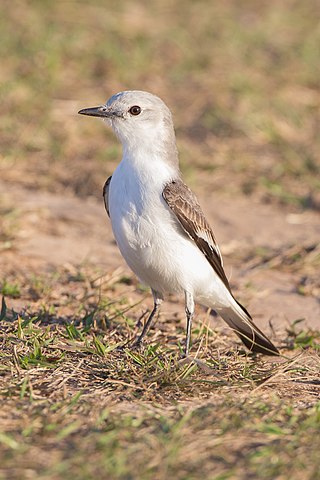Top Qs
Timeline
Chat
Perspective
White-rumped monjita
Species of bird From Wikipedia, the free encyclopedia
Remove ads
The white-rumped monjita (Xolmis velatus) is a species of bird in the family Tyrannidae, the tyrant flycatchers.[2] It is found in Bolivia, Brazil, Paraguay, and as a vagrant to Argentina.[3]
Remove ads
Taxonomy and systematics
The white-rumped monjita was formally described in 1823 as Muscicapa velata, a member of the Old World flycatcher family.[4] It was eventually transferred to genus Xolmis that had been erected in 1826. Because Xolmis is masculine, it was necessary to change the ending of the specific epithet to velatus.[5][6]
According to the IOC, the South American Classification Committee of the American Ornithological Society (SACC), and the Clements taxonomy, the white-rumped monjita shares genus Xolmis with only the white monjita (X. irupero).[2][5][7] However, as of December 2024 BirdLife International's Handbook of the Birds of the World includes six other species in addition to the white-rumped and white monjitas.[8] All agree that the white-rumped monjita is monotypic.
Remove ads
Description
The white-rumped monjita is 19 to 20 cm (7.5 to 7.9 in) long. The sexes have the same plumage. Adults have a mostly white head with a pearly gray nape. Their upperparts are mostly brownish gray with a white rump. The basal half of their tail is white and the rest black. Their wings are blackish with a white band at the base of the flight feathers that shows as a stripe in flight. Their inner secondaries and tertials also have a white patch. Their underparts are entirely white. They have a dark iris, a black bill, and dusky blackish legs and feet.[9]
Remove ads
Distribution and habitat
The white-rumped monjita is found in Brazil from the lower Amazon River in Pará and Maranhão south to Paraná and occasionally beyond, and west to southern Mato Grosso and Mato Grosso do Sul. Its range continues into northern and central Bolivia and northeastern Paraguay.[9][10][11] The SACC also has records of it as a vagrant in northern Argentina.[3] The white-rumped monjita inhabits open and semi-open landscapes such as savanna and grasslands with some bushes and trees, and is usually found near water. It often occurs around isolated human dwellings and on the outskirts of towns. In elevation it ranges up to about 1,000 m (3,300 ft).[9][10][11]
Behavior
Movement
This section needs expansion. You can help by adding to it. (July 2025) |
The white-rumped monjita is a year-round resident.[9]
Feeding
The white-rumped monjita feeds on insects, though details are lacking. It usually forages in pairs, perching somewhat tamely in the open on fence posts, wires, and bushes. It drops from the perch to the ground to capture prey and also hovers before dropping.[9]
Breeding
This section needs expansion. You can help by adding to it. (July 2025) |
Nothing is known about the white-rumped monjita's breeding biology.[9]
Vocalization
The white-rumped monjita is not highly vocal.[9] Its song is a "nasal, downslurred njeh, repeated at 1-sec intervals".[10] It sometimes gives a single whistle at night.[9]
Remove ads
Status
The IUCN has assessed the white-rumped monjita as being of Least Concern. It has a very large range; its population size is not known and is believed to be stable. No immediate threats have been identified.[1] It is considered fairly common and occurs in many national parks and other protected areas. It is "tolerant of converted habitat".[9]
References
Wikiwand - on
Seamless Wikipedia browsing. On steroids.
Remove ads




